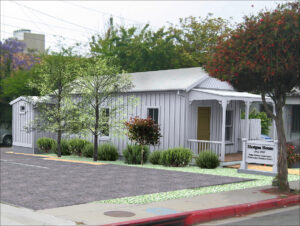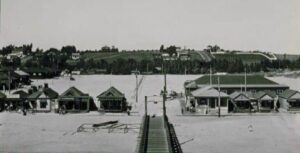OCEAN PARK — A house isn't a home if it doesn't have an address.
Officials with the Santa Monica Conservancy hope to finally have a date for when they can move the historic Shotgun House out of storage and into its final resting place, a lot on Norman Place at Second Street.

Once there the home, built in the 1890s and nearly demolished 16 years ago to make way for condominiums, will become the conservancy's Preservation Resource Center where homeowners and others can learn the economic benefits of restoration and preservation and the steps to get there, as well as how older structures can be reimagined and still be useful today.
The conservancy, a nonprofit dedicated to the preservation of historic structures in the city by the sea, recently secured a building permit from City Hall and has plans to put the house on a flatbed truck and drive it on over to Ocean Park, said Carol Lemlein, conservancy board president. The goal is to move the home on a Sunday so residents can come out and witness the event, and possibly become inspired.
"We're very enthusiastic," Lemlein said. "It's been a long time coming."
Originally located at 2712 Second St. in Ocean Park, the 468-square-foot structure is a classic "shotgun" house, members of the conservancy said. Architectural historians believe this type of house was first seen in the Caribbean (resulting from a blend of African and European influences). By the early 19th century this modest type of structure had spread into much of the American South, via New Orleans. Over time, shotgun houses became ubiquitous in the rural South and were particularly common as dwellings for African-Americans.
Inexpensive to build, easy to transport and adaptable to diverse purposes, the shotgun style spread across the country. Shotgun houses found use during the Civil War as field housing, sprung up in mining towns across the West, sheltered railroad workers laying tracks across the nation, and offered economical shelter for people of limited means in many communities.

In Santa Monica and other resort areas, shotgun homes were also useful as vacation cottages, Lemlein said.
Historians debate the origins of the name "shotgun." Some believe the word is a version of the Yoruba (African) word for house — "togun." Others cite the simple floor plan of these dwellings. Shotgun houses are typically one-room wide and two or three rooms deep. Lacking a hallway, the rooms are aligned with connecting doorways so that a bullet fired through the front door would exit cleanly through the back door, according to the conservancy.
This house is a good example of the form with three small rooms lined up in a row. Like most shotgun houses, this board-and-batten structure features a covered front porch and a gabled roof. Ornamentation is minimal but the diamond-shaped shingles on the front gable provide a hint of Queen Anne styling. (Originally the house also included some Victorian scrolled brackets on the porch posts. The conservancy has plans to recreate them.)
This particular house is significant for several reasons, according to the conservancy. First, it is largely unaltered since it was constructed. Because shotgun houses are so small, it is unusual to find examples today without major additions. Although this house is in urgent need of repair, its basic architectural integrity is strong.
This house is also important for its links to local history, harking back to the early days of Santa Monica's Ocean Park neighborhood. In the 1890s Ocean Park was being subdivided and settled and was growing fast as a resort area. In Ocean Park's first phase of development, shotgun houses were built or brought in by rail to serve as vacation cottages near the beach, according to the conservancy. This house was originally located just two blocks from the Santa Fe railroad depot in Ocean Park and within easy reach of the area's tourist attractions. As such it is linked with one of Santa Monica's oldest and most important industries — tourism.
The now-defunct Ocean Park Community Organization originally purchased the home and saved it from demolition. But when that neighborhood group folded after its chairman was accused of mishandling funds, the house was left without an owner at the Santa Monica Airport. City Hall took ownership and moved it a second time to a storage facility adjacent to Memorial Park to make way for construction of Airport Park.
In 2007, city officials settled on a permanent location, a parking lot next to the Ocean Park Library, also an historic structure. The conservancy was selected in 2010 by the City Council to manage it, agreeing to a 20-year lease.
The transformation of the Shotgun House into a Preservation Resource Center is supported by a $1.6 million fundraising campaign that includes hiring the conservancy's first executive director and expanding programming and community education.
Curriculum has already been developed by Santa Monica Landmarks Commissioner Nina Fresco to help teach youngsters about the home's history, what goes into moving a home and how communities change over time. The lessons are interactive, using kits that provide students the opportunity to build models of actual homes in the city's Third Street Neighborhood Historic District as they study the evolution of the neighborhood.
The conservancy still needs donations to reach its fundraising goal (it's raised just under $1 million) and is asking for those with building materials like sheetrock to consider donating them so that as much cash as possible can be saved and spent on programming and hiring staff. Skilled labor is also needed.
Those interested can learn more by visiting www.smconservancy.org
City Hall should be providing a moving date and preferred routes by the end of the week, Lemlein hopes.
"We will finally have a place to meet the public and have a common place to get work done that's not in our homes, so we think we can be much more effective educating and advocating," she added.
kevinh@www.smdp.com









